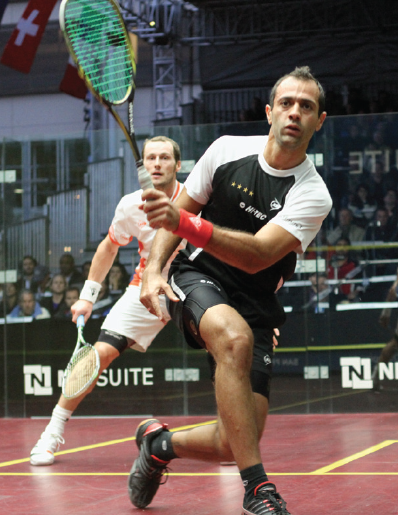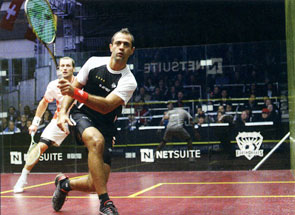By Richard Millman, Owner – The Squash Doctor Corporation
Squash is dependent on a continuous organic cycle of behavior which I call ‘The Rally Cycle’. This involves a continuous and seamless flow which passes through three key phases. Whether or not the phases are executed in the correct sequence determines a player’s ability to ‘live or die’ within the context of the rally and game.
Here is ‘The Rally Cycle’: PLAN… MOVE… HIT.
Really it should be shown in a circular diagram with each phase receiving equal emphasis.
Strange, is it not, that we as a community have developed a love affair with the ‘HIT’ portion of the cycle? When have you been to a Squash match and heard the spectators shout “Oh great move!” or better yet “Wow, great planning?”
Never, I suspect, because we as a society have skewed the importance of ‘SHOTS.’ Shots frankly may be the sexiest part of the cycle visually, but in actual fact are the least important part of the cycle.
It is an interesting fact that if you work on your shots, you will not move and your shots will get worse. If you work on your planning and movement, you will have more choices, you will move into position and your shots will get better.
Actually it’s no surprise at all, because the PLAN portion (which is Racquet Preparation) of the Rally Cycle drives the MOVE part (which is movement both into position for the shot and into position to defend the court-not just to the shot) of the cycle, which in turn fuels whatever amount of power you need to generate to propel the ball.
It is important to note that the movement to locate yourself in a position from which you can equilaterally defend the court (mistakenly described as getting to the T) must start momentarily before striking the ball (refer back to “Slingshot Mechanics,” Oct 2012). The additional value of this is that you are strategically positioned for the next phase of the game—the PLAN—in response to a shot from your opponent, before the opponent hits the ball. Thus you are physically up to date with the ball and mentally ahead.
Hitting the ball before you start your movement into position (sometimes called your ‘recovery’) results in you releasing the ball into play and then desperately trying to play ‘catch up’—hoping your opponent doesn’t hit the ball before you gain your position. That approach is simply bad organization which often is the negative product of too much emphasis on the HIT phase—where players spend too much time isolating stroke production from the continuity of the Rally Cycle.
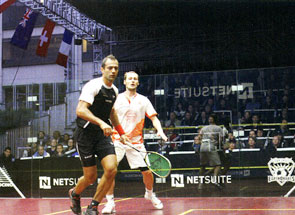
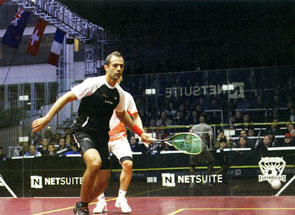
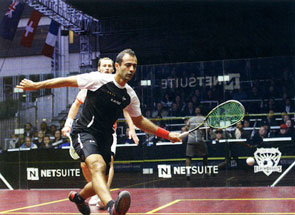
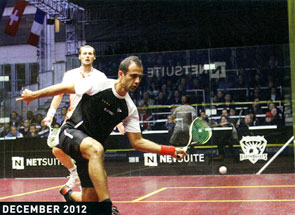
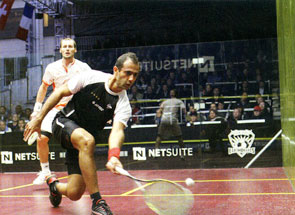
Looking at the photos of Amr Shabana, left to right and top to bottom, you can see how well he utilizes the “Rally Cycle” with early preparation (PLAN), his movement into the shot and off the ball as he swings through his forehand (MOVE and HIT). Shabana is one of the best on the professional tour at emphasizing his position on court in his shot selection and execution.
So you can see that getting the cycle’s sequence correct is extremely important. There are many world-class players who don’t get the cycle right and probably aren’t aware that their cycles are flawed. But because some of their abilities, such as athleticism or accuracy, are extraordinary they are able to make up a certain amount for their poor sequencing with extra qualities. However, as soon as they come up against someone who is as skilled or athletic as themselves, their philosophical shortcomings become obvious. Typical situations that arise as a result of a lack of understanding of sequencing are:
- Multiple lets and strokes because the player hits the ball too fast and before they start their movement into position, resulting in the opponent wanting to move to the ball when the striker is still standing where he was when he hit the ball. These players often complain about the lets—claiming that they are ‘in the middle’. It doesn’t matter that they are in the middle—if they are standing still when they hit the ball they make themselves into obstacles. If they glide off of the ball as they strike it, they both position themselves for the next phase of the rally and provide a clear path to the ball, forcing the opponent to have to retrieve their shot.
- The other situation indicative of poor understanding of sequencing is a gifted player hitting a seemingly brilliant shot and, then being caught out by their opponent retrieving it, exposing the the gifted player who is still standing in the same place as he struck the ball from. This player fails to understand that the primary purpose of a Squash shot is to facilitate the striker’s movement into position—not to beat the other player.
If you forget yourself in your ambition to hurt your opponent you will look as silly as Wiley Coyote when he attempts to blow up the Road Runner with dynamite only to realize when it’s too late that he has inadvertently walked over the edge of a 1,000 foot drop while he was attempting to kill his foe.
If you ever see a gifted technician with fantastic shots, having to make many amazingly athletic, last ditch retrievals, you will know they aren’t thinking through or don’t understand the correct sequence.
Before you attempt to hurt your opponent, always make sure of your own position in case your attack fails—which in Squash is most of the time. He who fails to plan, plans to fail.
So to sum up from last month and this article: The instincts required by a successful Squash player are those of ‘Life and Death’. In practical terms that means that a Squash player must use both their primary and peripheral attention systems to maintain a constant awareness of both their main interest (the ball) and their environment (everything except the ball—the court and the opponent). You must never allow your primary focus to stray to your opponent or to any well meant teaching aid (the T or a banana or big steps or your opponent’s body language). Attend primarily to the ball, and nothing else. Attend peripherally to everything else.
The system required by a successful Squash player is that of the Rally Cycle: PLAN… MOVE… HIT. If you get the sequence wrong—if you run before you prepare your racquet (the plan), or if you hit the ball before you start moving, or if your shot is not planned in consideration of the consequences to yourself—then the whole house of cards will come crashing down.
Practice these concepts, correctly, thousands of times. Gradually you will learn how to maintain a ‘Rallycentric’ thought process and rediscover the Survival instincts that made your ancestors successful.
How do I know your ancestors were successful? Easy—you’re here today in 2013 aren’t you?
Let’s just make sure that you are sharp enough and smart enough to use these techniques to survive.
If you use them on the Squash court you might just find that you become more successful off of the Squash court.
I will be publishing a short piece of video explaining this concept on my facebook page shortly. Keep your eye out for it.


